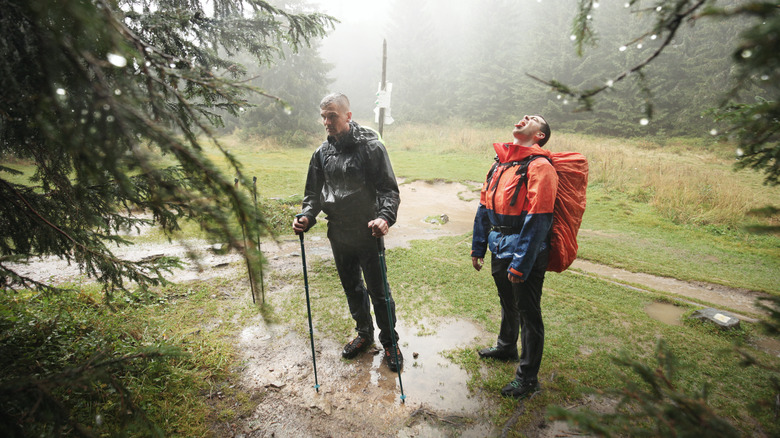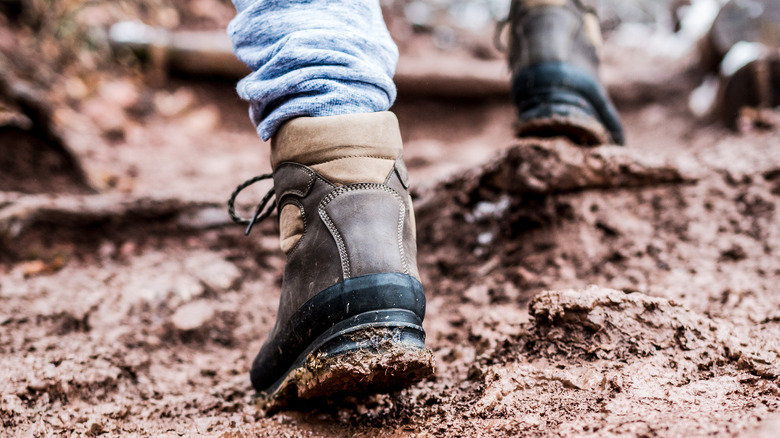How To Select The Best Hiking Boots For A Wet Hike
We may receive a commission on purchases made from links.
When it comes to hiking, taking care of your feet is essential to having an enjoyable trek. Choosing the proper hiking boots and socks are a critical component of accomplishing that task. However, even the best boots and socks won't be comfortable if they are soaking wet. So, if you will be hiking in these conditions, there are a few more factors that must be considered in order to select the best hiking boots for a wet hike. Taking the wrong boots for such an excursion is a massive hiking mistake.
This isn't just a comfort issue. Wearing the wrong hiking boots can be dangerous as well. If your feet get wet in cold weather, it can lead to hypothermia and frostbite. Not having boots that can provide good traction in wet conditions can make you more likely to slip and fall, potentially injuring you. While some hikes are planned with the knowledge that your feet will get wet, others become wet hikes unexpectedly due to the onset of rain, snow, or other weather conditions. With that in mind, it's a good idea to choose a boot capable of handling wet hiking conditions as your primary hiking boot.
Obviously waterproofing is key to keeping your feet dry. To that end, selecting hiking boots with good waterproofing is step one. However, some of the most water resilient materials, such as rubber, can heat up in a hurry and cause your feet to sweat, essentially getting wet from the inside. This can be equally uncomfortable and lead to blistering. It can also take boots longer to dry. Boots made from breathable waterproof materials such as Gore-Tex are a better choice, albeit a more expensive one. So, budget may be the deciding factor there.
Consider the terrain and time of year for your wet hike
When choosing hiking boots, there are three things to consider: type, components, and fit. Type refers to the style — boot, shoe, etc. Components are the pieces from which the boots are made. In order to be waterproof, the uppers, lowers, and other components must be made from or coated with waterproof materials. However, the style will also factor into the boots' ability to keep your feet dry as water can get in over the uppers. So, higher boots are more effective if you are moving through standing water.
You should also give some thought to the terrain you'll be hiking on. The outsole will need to be considered for this aspect. The size, shape, and pattern of lugs impact the boots performance. In mud, lugs that are spaced a greater distance apart will be more effective, as they tend to self-clean. Closely spaced lugs in shapes such as a hexagon will provide good traction at various angles on slippery surfaces. There is a myriad of options that fall somewhere in between. For casual hikes and hikers, boots with multi-purpose tread will provide versatility. However, if hiking specific terrain, like that found in some of the world's most dangerous hiking spots, match the best outsole to the terrain.
The time of year should also be taken into account. If you are hiking in warm weather and going to be getting wet, it opens up an entirely different set of options. There is a wide array of footwear designed for this type of wet hiking. Products such as the Keen Drift Creek H2 closed toe sandal and La Sportiva TX Canyon hiking shoe are meant to get wet, but dry quickly. When in cool or cold weather, however, it is essential to pick a boot that is made from quality waterproof material in order to keep your feet dry in wet conditions. Additionally, as your boots wear, it is a good idea to apply a waterproofing treatment from time-to-time to ensure they continue to repel water.

